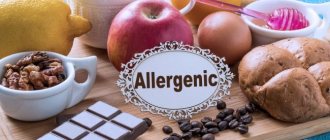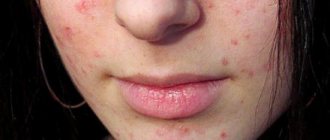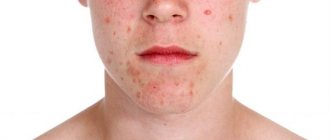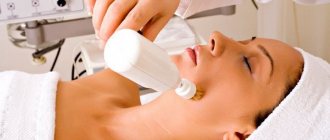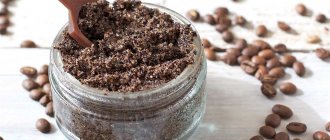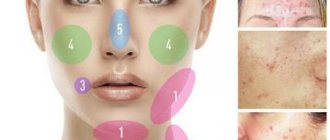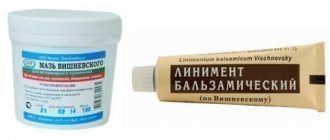Pimples on the butt: reasons for their appearance
| Causes of rashes on thighs | |
| Hormone imbalance | Typically, hormonal imbalance occurs in the presence of pathologies with the thyroid gland, during menopause and pregnancy in women, when taking steroid drugs, as well as in diabetes mellitus. |
| The person has stomach or intestinal diseases | In case of metabolic disorders and the presence of gastrointestinal pathologies (colitis, duodenitis, proctitis), the appearance of rashes in the thigh area is a common problem. |
| A person has diseases caused by viruses or bacteria. | Staphylococcus aureus, which is found in the human body, provokes the formation of boils (pimples filled with purulent contents) on the buttocks. |
| The presence of a histamine reaction in a person | Pimples on the butt can develop as a result of a banal allergy. Strong-smelling washing powder, sanitary pads, and even toilet paper can trigger the development of an allergic reaction. |
| Limited mobility | Very often, people who have a “sedentary” job and who have limited mobility suffer from the appearance of acne on the butt. |
| Vitamin deficiency | If a person has a deficiency of vitamin A, B, C or E, skin problems in the form of acne cannot be avoided. |
| Hyperhidrosis | When you sweat excessively, the pores become blocked and sebum is trapped inside them. Because of this, purulent plugs appear and, as a result, rashes in the thigh area. |
| Dry skin type | People with dry skin are more prone to acne in the thigh area. |
| Keratinization disorders | When keratinization is disrupted, scales form on the skin and it begins to peel off. Dry skin, as a result, causes the formation of rashes. |
| Insufficient hygiene | If a person wears dirty underwear and lacks careful hygiene, the appearance of acne on the butt is guaranteed. |
Stages and types of acne
There are four stages of acne.
- First stage. The easiest stage is when closed comedones form in small quantities on the skin, which are white subcutaneous acne without inflammation and the formation of pustules.
- Second stage. It is characterized by the appearance of not only closed, but also open comedones (blackheads), as well as small inflamed lumps and pustules in an amount of no more than two dozen.
- Third stage. Quite a lot of purulent formations and nodules appear on the skin.
- Fourth stage. More than forty purulent pimples and large lumps (nodules) indicate a serious inflammatory process.
Acne can be divided into several types:
- blackheads or open comedones - sebum, mixed with external impurities, forms a sebaceous plug, which oxidizes and becomes gray or black;
- closed comedones, or subcutaneous acne, are formed in the same way as open ones, but since they are under the skin and do not come into contact with oxygen, they are white and do not become inflamed;
- papules - small subcutaneous nodules without signs of inflammation;
- pustules - purulent pimples;
- nodules - painful, dense and hard to the touch nodes, often filled with pus;
- boils - acute purulent inflammatory processes in the follicle or sebaceous gland, which are usually caused by Staphylococcus aureus;
- allergic rash - small rashes that are characterized by severe itching.
Dry skin
There are various reasons for dry skin:
- Age-related changes and individual characteristics of the body.
- Insufficient fluid intake.
- Poor nutrition.
- Lack of vitamins.
- Wrong choice of hygiene products.
- Adverse weather conditions (scorching sun, severe frost, temperature changes).
Under the influence of the adverse factors described above, the skin becomes dehydrated and begins to peel. Dry skin is more sensitive, so inflammation and acne appear more often.
How to get rid of acne on the butt if it appears in a person with dry skin type, the following tips will tell you:
- Drink enough water – up to two liters per day. This volume of liquid normalizes the body's water balance.
- Provide a balanced diet with the correct ratio of proteins, fats and carbohydrates.
- If there is a lack of vitamins, take vitamin complexes, which include vitamins A, B, C, E.
- Choose suitable hygiene products that will not dry out the skin in the buttocks area. You should also moisturize your skin with nourishing and fortified creams.
- Try to limit your stay in adverse weather conditions.
Causes
The main factors that can lead to the formation of acne and irritation on the smooth skin of the buttocks include the following:
- Unsuitable clothing - uncomfortable cut of products, synthetic non-breathable materials, constricting trousers, overly tight underwear, panties made from fabrics containing low-quality fibers;
- Low physical activity - mainly due to a sedentary lifestyle, work that requires constant stay at the desk;
- Allergic reactions - may be associated with the body’s rejection of the components of hygiene or detergents, washing powder for clothes, or with changes in diet;
- Failure to comply with hygiene standards - poor quality of skin cleansing, prolonged wearing of stale underwear;
- Vitamin deficiency - lack of vitamins B, D, accompanied by dryness of the dermis and peeling of its surface;
- Problems in the functioning of the gastrointestinal tract - excess formation of toxins in the body, the elimination of which does not occur naturally through the intestines, but with the involvement of the skin, which helps cleanse the body;
- Unsuitable temperature conditions - the habit of sitting on cold surfaces, on the ground in the cool season, wearing clothes that are not appropriate for weather conditions, too warm, leading to excessive sweating, or too light, causing hypothermia of certain parts of the body;
- Hormonal disorders - disruptions in the hormonal system may be associated with women reaching a certain age, the use of contraceptives, and other reasons;
- Thin skin - a feature of the epidermis localized in the buttocks area is the lack of sufficient subcutaneous layer and low production of sebum, which helps moisturize the skin surface, which leads to an increased risk of irritation and acne.
Due to the fact that acne in the gluteal region can form deep under the skin in soft tissues and only appear on the surface of the epidermis after some time, this process can take a long time, causing pain.
Doctors call the most common cause of inflammation on the buttocks an inflammatory process associated with hypothermia, aggravated by infection.
Also, according to medical observations, this problem affects men more often than women, which is due to the fact that men's skin sweats more and is prone to the formation of acne.
Excessive sweating
Excessive sweating or hyperhidrosis is another reason for the development of rashes on the buttocks. The sebaceous glands become clogged with sweat secretions, which subsequently leads to the development of an inflammatory process.
Hyperhidrosis can develop when:
- Hormonal imbalance.
- Increased secretion of sebaceous and sweat glands.
- Stressful situations.
Before carrying out medical therapy for acne caused by hypothyroidism, the root cause that caused this condition should be eliminated.
An endocrinologist will tell you how to get rid of acne on the butt due to excessive sweating as a result of hormonal imbalance. Perhaps a person has endocrine diseases, which provoke the appearance of rashes.
When a person wears tight underwear made from artificial materials, heat transfer is disrupted, which results in increased sweating. Therefore, when purchasing underwear, you should give preference to natural fabrics.
Pathogenesis
The development of acne is associated with a number of different factors. Among them are increased secretion of the sebaceous glands, impaired keratinization of the mouths of hair follicles, tissue inflammation, etc. An important role in the formation of acne is played by excessive secretion of sebum, as well as a decrease in its bactericidal properties.
In addition, the development of such formations is often associated with hypercolonization of pathogenic microorganisms. Acne develops both due to the bacterial influence of microorganisms and due to their pronounced excretory properties. Such properties lead to the release of fatty acids.
Bacterial sensitization of the body in the presence of foci of chronic infection is also of some importance. This leads to a decrease in nonspecific skin resistance.
Thus, the occurrence of acne is often associated with a weakening of nonspecific skin resistance, which decreases under the influence of a number of different factors.
"Sedentary" profession
The problem of acne in the thigh area most often affects people whose professions require them to constantly sit in a sitting position. When a person sits on an armchair or stool, heat exchange in the gluteal region is disrupted and the skin rubs. This leads to the formation of acne in the thigh area.
Also, in a sitting position, blood does not flow in the required quantity to the pelvic organs and buttocks. Because of this, cells renew themselves more slowly, pores become clogged, and inflammation develops.
When working at a computer for a long time, you should get up for a while and take short walks. You can also perform a set of exercises that will involve your legs and buttocks. This will ensure blood circulation.
Changes in hormonal levels
Hormonal imbalance can also lead to rashes on the thighs. Upon palpation, you will notice that such pimples are large in size and very painful if they come into contact with clothing. Over time, such pimples “mature” and purulent contents are released from them.
If the cause of acne is a hormonal imbalance, you cannot do without a medical examination. A visit to specialized specialists (endocrinologist, gynecologist, dermatologist) is mandatory.
Doctors will check the level of hormones in the blood and prescribe appropriate treatment. The main treatment consists of taking medications to normalize hormonal levels and using drying agents.
Keratinization disorder
Disorders of skin keratinization can be hereditary, as well as acquired after various skin diseases. With this disease, the function of self-cleaning of the epidermis from dead skin flakes, which clog the skin pores, excretory ducts of the sweat and sebaceous glands, is disrupted. Clogged sebaceous glands and pores become comedones, and if inflammation occurs, pimples.
Treatment of rashes with this disease is supportive. Careful skin care is very important. The use of glycerin-based soap is not recommended. Drying products will help remove acne on the buttocks.
Allergic dermatitis
Acne in the thigh area with allergic dermatitis can appear as a result of:
- food allergies;
- use of personal hygiene products containing large amounts of fragrances and fragrances;
- when wearing synthetic underwear.
With allergic dermatitis, the thighs are covered with pimples, redness and swelling of the skin are observed. These pimples are very similar to the rash of hives.
If the rash on the thighs is caused by an allergy, you need to visit an allergist and conduct a test to determine sensitivity to products.
Prevention
By following the rules of prevention, you can significantly reduce the likelihood of developing rashes. It is advisable to adhere to the following recommendations:
- Do not wear underwear or items made from synthetic fabrics. You should not wear thongs in winter to prevent hypothermia. During an exacerbation period, you should avoid very tight skirts and trousers.
- It is important to be physically active. A sedentary lifestyle is a factor that increases the risk of rashes. For those who have a sedentary job, it is advisable to do several exercises every two hours. You should definitely take a walk in the fresh air every day.
- Avoid sitting on cold surfaces, especially in winter.
- Follow the rules of hygiene: change bed linen at least once a week, change underwear every day. Maintain personal hygiene: wash yourself twice a day, be sure to dry your skin with a towel.
- It is recommended to choose hypoallergenic soap and other hygiene products.
- Eat right, eliminating harmful foods from your diet.
- On the recommendation of a doctor, you can use multivitamin complexes.
- If the rash persists for a long time, you should visit a dermatologist.
Hypothermia
With general or local hypothermia, the body is less resistant to pathogens. This in turn leads to cold rashes appearing in the thigh area.
The structure of acne during hypothermia is more dense, unlike ordinary acne. They have no apex and are very painful.
Your therapist will tell you how to get rid of pimples on your butt if they appeared as a result of a cold. In addition to general restorative therapy, local treatment of acne is necessary. There is no point in delaying the treatment of the disease due to hypothermia, since pimples that appear harmless at first glance can turn into boils.
Classification
Pimples on the butt can come in different colors, shapes and sizes. There are several types of such formations:
- Cysts are small formations that look like swellings of the skin. This formation affects the deep layers of the epidermis. Inside the cyst there is serous content.
- A boil is a fairly large pimple on the butt. A large boil is formed under the influence of pathogenic microorganisms. Such purulent pimples on the butt are very painful. Purulent pimples often appear under the influence of Staphylococcus aureus .
- Papule – located above the surface of the skin. The formation looks like a nodule, there is no pus in it.
- Node - when such a formation is formed, signs of inflammation are observed. These red pimples are usually multiple.
- Pustule - can form both under the skin and above it. There is always purulent content inside.
- Comedones are dense formations that, due to blockage, contain dirt and fat. If irritation occurs, the pimple may hurt and cause discomfort.
How to get rid of acne on the buttocks: quick and effective methods
Ointments based on salicylic acid, benzoyl peroxide and alpha hydroxy acid are good for eliminating acne on the buttocks. Such products are applied to clean skin. It should be noted that ointments containing benzoyl peroxide severely stain clothing. Therefore, when using this product you need to wear old clothes.
Regular ice will help reduce the inflammatory process when acne appears on the buttocks. It also relieves pain well, resulting in significant relief. The procedure is extremely simple - several ice cubes are wrapped in a towel and applied to the affected area for 20 minutes.
Citrus essential oils, rosemary and eucalyptus oils have a pronounced antibacterial and antifungal effect. Pimples in the thigh area are lubricated with these products up to five times a day.
Iodine has a good drying effect. They apply it to pimples on the butt several times a day. But before use, you need to check whether the person is allergic to this antibacterial agent.
Doctors also recommend salicylic acid-based ointment to get rid of rashes. It has an antibacterial effect and also dries the skin well. Painful pimples are lubricated with ointment in a small amount, spreading over the surface of the skin. After just two days, a positive effect will be noticeable.
Don't miss the most popular article in the section: Morning exercises for those over 40, 50. Gymnastics exercises for weight loss, video lessons.
Medications for acne on the butt: instructions
Only a specialist can tell you how to get rid of pimples on your butt if there are a lot of them and they don’t go away for a very long time. The dermatologist will prescribe medications and give certain recommendations for their use.
Most often, specialists prescribe ointments to the patient. They are applied to the affected areas up to three times a day. A very important rule is that ointments for treating acne are applied exclusively to clean and dry skin.
Ointments can provoke the development of a histamine reaction, so before applying them, you need to check whether the skin reacts normally. To do this, a small amount of the medication is applied to the wrist for 5 minutes. and see how the skin reacts. If there is no reaction in the form of redness, the product is not contraindicated for use.
After using medications, the skin may peel, turn red, and even itch. If side effects are intolerable, it is recommended to stop using the drug.
Tsindol, Zenerit, Baziron are medications that do an excellent job with skin rashes.
Purulent rashes on the butt can be removed with Erythromycin ointment. A small amount of antibacterial ointment is applied to the skin in the morning and evening. The recommended treatment course is 21 days. Even if the condition of the skin has improved, you should not stop the treatment course. This will allow you to achieve better results in the treatment process.
Zenerite
Zinerit works great for acne in the thigh area. This drug penetrates deep into the skin and thereby has a beneficial healing effect on it.
The affected areas are thoroughly washed before using Zinerit. The product comes with a special applicator, which is used to apply the product. It is recommended to repeat the procedure 2 times a day.
The drug should not be used by pregnant women, during lactation, or by people with an allergic reaction to zinc. If the product gets on the mucous membranes or in the eyes, rinse it off immediately with plenty of water.
Baziron AS
Baziron is an antimicrobial drug based on benzoyl peroxide. It has proven itself well in the treatment of rashes on the butt.
A little gel is applied to the pimples, rubbing evenly over the surface. Before using the drug, it is important to cleanse the skin.
The good thing about this drug is that it kills pathogenic microorganisms, but at the same time does not dry out the skin. The recommended treatment course with the drug is at least 4 weeks.
Contraindications for use are children under 12 years of age and an allergic reaction to the components of the drug.
Tsindol
Tsindol is a zinc-based drug that is used to treat dermatitis, eczema, diaper rash, and acne. The product is available in the form of a suspension.
Tsindol is applied to the skin with a cotton pad and after application you need to wait up to 15 minutes for it to dry. To treat acne on the buttocks, the suspension is used up to 4 times a day.
A significant advantage of the drug is that it can be used by children from birth and pregnant women. Side effects after using the drug are rare.
Characteristics of acne
Let's look at this in more detail. Absolutely all people, regardless of age and gender, have small pimples on their buttocks. They may have a flesh-colored tint, and sometimes turn red or even blue. However, there are times when subcutaneous formations appear, which when pressed are very painful. In this case, swelling and hyperthermia may occur. In some cases, acne is accompanied by purulent discharge that infects the surrounding epidermis.
According to doctors, patients very rarely go to the hospital with complaints that a large pimple has appeared on their butt. This is due to the structural features of the epidermis of the buttocks. In this area of the human body there are very small pores that almost never become dirty. If this happens, then a closed comedon is formed.
Then everything happens according to the following scheme:
- if not only dirt, but also infection gets into the pore, then a purulent process begins;
- if infection has not occurred and the person’s immune system works well, then a node will form;
- if inflammation does not occur, then the person lives with comedones without any inconvenience.
If a large pimple appears on the butt and it hurts, then this indicates an infectious infection. As a result, a rash forms on the buttocks, which can occupy an impressive area of skin. As a rule, blackheads are watery and burst when pressed. Dermatologists recommend not to self-medicate, but to immediately seek help from a hospital, since the infection can lead to very serious consequences.
Traditional recipes for combating acne on the buttocks
Folk remedies will help get rid of severe acne on the butt, if medications do not work.
Honey massage has a good healing effect for treating acne. A little honey is heated and applied to moisturized skin. Then gently massage the affected areas on the buttocks. The duration of the procedure is 20 minutes.
If you regularly take baths with salt, acne on the buttocks will go away much faster. Salt is poured into a bowl of warm water at the rate of 15 g per 1 liter of water. Mix everything thoroughly and sit in the bath for 20 minutes. After the procedure, the salt is washed off so as not to dry out the skin.
A mixture of boric alcohol and laundry soap quickly eliminates acne in the thigh area. To do this, grate the laundry soap and add 20 ml of boric alcohol. The resulting paste is applied to the skin of the buttocks for 15 minutes. After the procedure, the mixture is washed off with warm water.
Tar soap
Birch tar, which is a component of tar soap, is famous for its anti-inflammatory properties. Tar soap also has a drying effect, which makes pimples on the butt go away faster.
Using tar soap to get rid of acne is very simple. Before going to bed, you should wash your buttocks with this cosmetic product. However, birch tar can cause skin irritation, so you should check for an allergic reaction before using it.
Sea salt
Sea salt contains beneficial substances and valuable chemical elements that have a beneficial effect on the skin. You can use sea salt to get rid of acne on the buttocks in the form of a scrub, bath or lotion.
Salt baths are made at the rate of 0.5 kg of salt per 210 liters of water. The duration of the procedures is no more than 15 minutes. Such baths are carried out up to four times a week. After the procedure, you should take a warm shower.
To prepare an anti-acne scrub, mix a pinch of sea salt with 30 ml of olive oil, the same amount of honey and 15 ml of fresh lemon juice. The resulting mixture is gently rubbed into the skin. After the procedure, the mixture is washed off with warm water.
To prepare the lotion, dissolve 30 g of sea salt in 200 ml of boiling water. When the solution has cooled, soak a cotton pad in it and wipe the affected areas several times a day. Saturated salt dries the skin and eliminates the inflammatory process on the buttocks.
Cosmetic clay
A mask based on cosmetic clay will help remove acne and inflammation on the skin of the buttocks. You can use any clay that suits a particular skin type - white, black, blue or pink. The clay powder is diluted with warm water or herbal decoction to the consistency of thick sour cream.
The resulting mixture is applied to the affected areas in a thin layer. Keep the mask until the clay begins to dry. When the mask begins to dry out, it should be washed off, since clay can cause dry skin. After the procedure, it is recommended to lubricate the buttock area with a nourishing cream.
Phytotherapy
Herbal medicine or treatment with medicinal herbs is effective for acne on the butt.
A decoction of celandine, chamomile and string perfectly relieves inflammation on the buttocks. To prepare a bath, you can use all the plants at once, or take each plant separately.
The herbal decoction is prepared according to the instructions for use. Pour 200 ml of strong broth into a bowl of water. The entire buttocks are immersed in the resulting solution for 15 minutes. The procedure is carried out up to three times a day.
Topical use of calendula tincture will also help remove acne on the buttocks. With this product you can make compresses and also use it as a lotion.
Compresses are made as follows: a cotton pad is moistened in the tincture and applied to the pimples, fixing with a band-aid. It is advisable to perform the procedure at night. Also, with the tincture, like a lotion, you need to lubricate acne on the buttocks up to 5 times a day.
Regular plantain will help in treating acne on the butt. The leaves of the plant are thoroughly washed under the tap and dried. Then they are passed through a meat grinder and juice is made from the resulting mass. The juice is used to wipe the skin of the buttocks instead of lotion in the morning, afternoon and evening.
Aloe
A natural antiseptic is the aloe plant. It perfectly removes purulent inflammation on the buttocks, heals wounds, and has a restorative and bactericidal effect.
To get rid of acne on the butt, wipe the skin with the juice of the plant three times a day. The first results will appear after 7 days. Of course, the effect of using the product will not be the same as after using antibiotics or special ointments, but it is safe and has no contraindications.
Diet to prevent acne on the butt
To prevent acne on your buttocks, you should review your diet. It is possible that poor nutrition contributes to the development of this disease.
How to eat to prevent the appearance of acne on the butt:
- Increased activity of the sebaceous glands is provoked by foods that contain harmful cholesterol. You should say “no” to foods that are too fatty, salty and spicy. Taboos are introduced on smoked meats, fatty meats, fast food, cakes, etc.
- It is not recommended to overeat. It is better to eat several times a day, but in small portions.
- Nutrition should be balanced. So, in the morning you are allowed to include carbohydrate dishes in your diet. In the evening, it is better to give preference to light, low-calorie dishes that will not burden your stomach before bed.
- Throughout the day you need to drink at least 1.5 liters of liquid per day. But it should be regular drinking water, not sweet carbonated drinks. The consumption of alcoholic beverages when acne appears on the buttocks should be completely limited.
- It is recommended to include low-fat cottage cheese, fish, and lean meats in your diet. It is better to cook steamed vegetables and cereals as a side dish.
- Throughout the day, it is better to eat fruits that do not cause an allergic reaction.
- Green tea is a source of catechin. This is an anti-inflammatory chemical element that removes free radicals from the body that harm the skin. It is recommended to drink several cups of green tea throughout the day. And if pimples appear on the buttocks, you can wipe them with a saturated solution of green tea.
- The health of skin cells is ensured by an element such as selenium. It is found in sufficient quantities in nuts and wheat, so you should not avoid these products.
To get rid of acne on the butt, you need to rationalize your diet in favor of healthy foods, drink enough fluids, use natural cosmetics, carefully adhere to body hygiene and promptly consult a dermatologist if necessary.
Article design: Mila Friedan
Diet
Diet for acne
- Efficacy: therapeutic effect after 21-30 days
- Terms: 6-8 months
- Cost of products: 1700-1800 rubles. in Week
If you have a rash, you should definitely make adjustments to your diet. It is important that your diet is as healthy as possible. Therefore, you should exclude those products that are determined to be harmful. We are talking about soda, fast food, snacks, fried foods, canned food, fatty sauces, smoked foods, and spicy foods. It is important to minimize sweets, alcohol, and coffee.
Ideally, the diet should contain a minimum amount of foods with dyes, preservatives, and sweeteners.
The diet must include the following products:
- Vegetables – raw and boiled.
- Fish, seafood.
- Vegetable oils.
- Berries, fruits.
- Lean meat.
- Dairy products.
- Cereal porridge
- Dried fruits.
